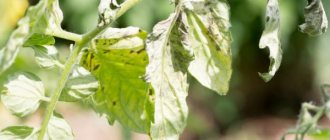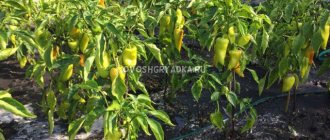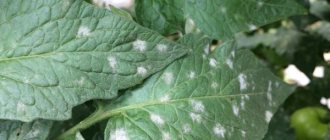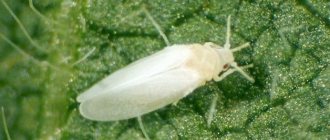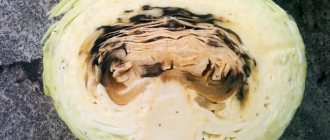Main causes of blackening
Many gardeners are interested in the question - what are these black spots on tomatoes and how to deal with them. Experienced gardeners say that this problem can arise for several reasons, among the most common are:
- Late blight. The main symptom is blackened tomatoes. This blackness is caused by the spread of fungus.
- Gray rot. Occurs due to a fungal disease.
- Alternaria blight. Dry brown spots appear on tomatoes caused by a parasitic fungus.
- Dry soil. If you do not water your tomato bushes regularly, blackening may also occur.
- Stem necrosis. The main symptom is the formation of cracks in the lower part of the stem. Caused by viruses.
- Lack of care. With insufficient fertilizer in the soil and little watering, blackening of tomatoes also occurs.
Blackening on tomatoes
Important! If dark spots have formed on green tomatoes, this indicates the presence of serious problems that can be eliminated with the right approach.
Bronzing of leaves
Yellow spots on tomato leaves may appear due to the bronzing virus. Symptoms: the edges of the leaves dry out and at the same time bronze or brownish-yellow spots appear. Sometimes they merge or become ring-like. In general, the plant looks sick, depressed, and has more shoots than a healthy bush. The fruits are few and may be small and deformed. With this disease, the top often dries out. The virus is not transmitted through seeds, but other plants can be infected when caring for them.
Affected plants are removed. In order to prevent the spread of the virus, gloves and gardening tools are treated with a solution of potassium permanganate. In the fall, it is necessary to disinfect the soil thermally.
Increasingly, gardeners in the middle zone are faced with a strange tomato disease. First, light transparent spots appear on the fruits.
As the berries ripen, they increase in size, capturing up to half the volume of the fruit.
At the same time, their flesh when cut is hard and not edible.
Typically, such fruits are formed when tomatoes are infected with mosaic viruses (VMT) or stolbur. However, when affected by these diseases, deformation of the leaves must be observed, and in case of stolbur, also parts of the flowers.
The pathogens persist in winter in perennial weeds and ornamental plants growing around the greenhouse, and in May-June they infect young tomato plants with the help of aphids and leafhoppers.
That is why autumn disinfection of the greenhouse with sulfur bombs and the correct techniques to reduce the number of pests and pathogens in the greenhouse do not work against TMV and stolbur. For protection, it is important to use healthy seeds, strong seedlings and prevent insects from entering the greenhouse.
The formation of spots is also associated with physiological diseases, such as potassium deficiency. Moreover, a deficiency can be observed even when plants are fed with ash due to an excess of nitrogen fertilizers.
Spots can also appear as a result of high daytime temperatures during fruit formation - filling of tomatoes. At temperatures above 32°, the formation of lycopene and carotene pigments in fruits stops, and only yellow coloring substances are formed.
The nutritional value of fruits with yellow spots is greatly reduced, but even red fruits ripened at high temperatures contain less carotene. Large-fruited varieties are more susceptible to this scourge, the fruits of which are heated unevenly, and overheated areas lose resistance to sunlight. By the way, in the case of sunburn, light gray spots with a dead surface form on the surface of the fruit. The correctness of the diagnosis will be confirmed by the fact that some of the flowers on the bush or even all the flowers on individual clusters dry out without forming ovaries.
This happens due to the fact that at temperatures above 35° pollen is sterilized.
By the way, high temperatures combined with uneven watering lead to cracking of the fruits.
To protect tomatoes from physiological diseases, I recommend: regularly; whitewash the roof or place reflective material over the greenhouse, such as white non-woven fabric or foil; carry out cooling waterings in the first half of the day (after lunch, excess moisture should disappear); Treat the bushes completely with a solution of humates, and not just water them at the roots. If these measures do not help, replace the variety with one more resistant to unfavorable growing conditions.
© A. TRUSEVICH, Candidate of Agricultural Sciences, Kursk
Below are other entries on the topic “Do-it-yourself cottage and garden”
Most summer residents and simply tomato lovers are faced with the problem of spots appearing on tomato leaves. This symptom is evidence that the plant has a disease such as brown spot. However, by taking timely measures, you can not only get rid of cladosporiosis (the second name of the disease), but also prevent its occurrence.
Conditions of high humidity and temperature in greenhouse conditions are concomitant for the development of the disease. Typically stains appear on the back of the bottom sheets. When they appear, they are gray in color, which gradually turns brown. The spots are velvety to the touch, and their shape is unclear.
After some time, spots appear on the other side of the organs. At first they are not too noticeable, as they are light green in color. But over time, the spots become brown with a yellowish tint, after which they may even become lighter. Their shape is usually incomprehensible. The spots are not too large: the maximum size is usually 0.01 meters. Starting from the lower leaves, cladosporiosis gradually spreads throughout the plant. This is facilitated by the spread of pathogenic spores during watering.
Why do tomatoes turn black in a greenhouse?
The crop can turn black not only in open ground, but also in a greenhouse. Therefore, it is necessary to understand why tomatoes turn black in a greenhouse and how to deal with it. Although the fruits are protected from adverse external influences, it is still necessary to maintain comfortable conditions in the greenhouse. If the care rules are not followed, you can lose a significant amount of the harvest, so it is necessary to start treating tomatoes in a timely manner.
Reasons for blackening of greenhouse tomatoes
Among the main reasons for the appearance of rot in a greenhouse, it is worth highlighting:
- soil contamination;
- high air humidity;
- incorrect temperature conditions;
- insufficient amount of fertilizers.
If it was noticed that green tomatoes began to darken, then it could be either frequent watering or too acidic soil.
Stains left by pests
At the seedling stage, tomatoes should not have pests. It is the gardeners’ fault that they appear. Stains can be left by:
- Whitefly. This is a gnawing pest, but you can’t avoid it. Firstly, the whitefly lays eggs that look like white spots; the larvae leave yellow dots when feeding. And secondly, the insect is a carrier of sooty fungus, which causes the leaves to turn black.
- Spider mite. The first manifestation of the pest is yellow dots on the leaves of seedlings. The underside of the plate is covered with a gray coating and thin cobwebs. Appears when indoor flowers are close together or is carried by people and pets. Spreads in dry air and high temperatures.
- Aphid. A sucking pest, it leaves dots on the leaves, but it is impossible to see them under a layer of small insects. They themselves look like elongated black or red spots.
- Nightshade miner. Quarantine pest of open and protected ground. The greatest danger is posed by larvae that gnaw passages inside the leaves and leave transparent spots. It is found in the soil and on seed material, from where it gets onto tomato seedlings.
Pests need to be controlled with insecticides, preferably systemic ones. It is difficult to destroy spider mites; the preparations must have an acaricidal effect.
Folk methods of struggle
If tomatoes turn black on the bottom, folk methods will tell you what to do in this case. Here are the most common recipes that prevent the formation of spots on fruits.
Traditional methods of combating crop darkening
- Recipe No. 1. Squeeze 300 grams of garlic into 10 liters of water and leave to steep for 24 hours. After the time has passed, spray the tomatoes with the prepared solution.
- Recipe No. 2. You need to dilute 100 grams of kefir in 1 liter of water and spray it on the plants. Lactic acid products will prevent the fungus from multiplying and infecting tomatoes.
- Recipe No. 3. You need to make a solution: dissolve 1 glass of salt in 5 liters of water. Spray the tomatoes periodically with the prepared mixture until they are completely ripe.
Worth knowing! Using folk recipes, you can protect the crop from fungal proliferation and prevent the formation of other problems.
Late blight (late blight)
Distributed everywhere. The cause of the disease is fungal infection. The fungus overwinters in plant debris. Late blight progresses in warm and humid weather and with prolonged rainfall. The disease most often affects fruits, and to a lesser extent, trunks and leaves.
Late blight can be easily identified by its external signs - these are brown spots with no clear shape. Tomatoes are affected during the period of milky ripeness and at the ripening stage. The spots quickly increase in size and in a short period of time affect the entire fruit. The inside of the tomato becomes dark brown and the fruit itself becomes soft. On the tops, the disease is noticeable by brown spots, and on the reverse side of the leaves you can see a small white coating.
Preventive protective measures include a ban on planting tomatoes next to potatoes, elimination of affected fruits and tops leftovers after harvesting, and alternating crops during planting.
Control measures when late blight is detected include spraying with fungicide solutions - “Profit Gold”, “Bordeaux liquid”, “Kaptan”, “Fthalan”, “Kuprozan”, “Polycarbocid”, copper oxychloride (“HOM”, “Polychom”), “ Tsineb", "Polymarcin", "Fitosporin". Treatments are carried out 2-4 times, with an interval of 1-2 weeks.
Chemicals
Folk remedies may not help in all cases. Every owner of a greenhouse or plot needs to know if black spots appear on tomatoes, what to do and what medicines to buy. It should be noted that the method of treatment is determined depending on what exactly the plant is infected with.
- Late blight. It is worth choosing medications such as Trichopolum, Hom, Fitosporin.
- Gray rot. Before you start spraying the plant, you must remove the infected fruits. If the rot is weak, you can use such remedies as Champion or Topaz, but if the problem is large-scale, then it is worth purchasing Ordan, Fundazol or Skor.
- Apex rot. A good remedy for treating the problem is Bordeaux mixture, which is prepared according to the following recipe: mix 100 g of quicklime in 1 liter of water, and dissolve 100 grams of copper sulfate in another container in 9 liters of water. Mix these two solutions and spray the bushes with tomatoes.
- Stem necrosis. Nothing will help the plant. The bushes must be torn out and burned, and the soil treated with Fitolavin.
- Alternaria blight. The plant must be treated with Ridomil, Antrakol, Ditan, Flint and other means. Treatment is carried out no more often than once every two weeks.
Consequences of the disease
Spotting on the leaves of bushes will definitely affect the harvest. At best, individual fruits will deteriorate; at worst, all plants will die. If measures are not taken, the bush with spots completely stops development and dies within a few weeks. First the leaves will fall off, then the tomatoes. Even if the tomatoes remain hanging on the bush, they will lose their characteristic taste and smell, and the seeds in them will turn brown.
It is better not to eat fruits from an affected bush, and especially not to use their grains as seed material.
How can you treat tomatoes after harvest?
After the tomatoes have been harvested, they must be properly prepared for long-term storage. To do this, you need to treat the tomatoes with hot water: put them in water for a few minutes, at a temperature no higher than 60 degrees.
After time has passed, remove the fruits and let them dry naturally. This way, the rot will not spread further, and the fruits will be able to be preserved for some time.
Processing tomatoes after harvest
Types of blossom end rot and its symptoms
Tomato blossom end rot has two forms :
- Physiological. Mostly on green fruits, a small depressed spot appears, which becomes brown and dry as it grows.
- Bacterial. It appears in the form of not a dry, but a wet spot, first light green and then brown in color. The fruit gradually turns into a brown rotting mass with a specific odor. Moreover, such rot most often affects not green, but already ripening tomatoes, primarily elongated fruits, as well as those lying on the ground. The latter may be healthy outwardly, since they often begin to rot from the inside, and only on a cut can black dead tissue be detected.
